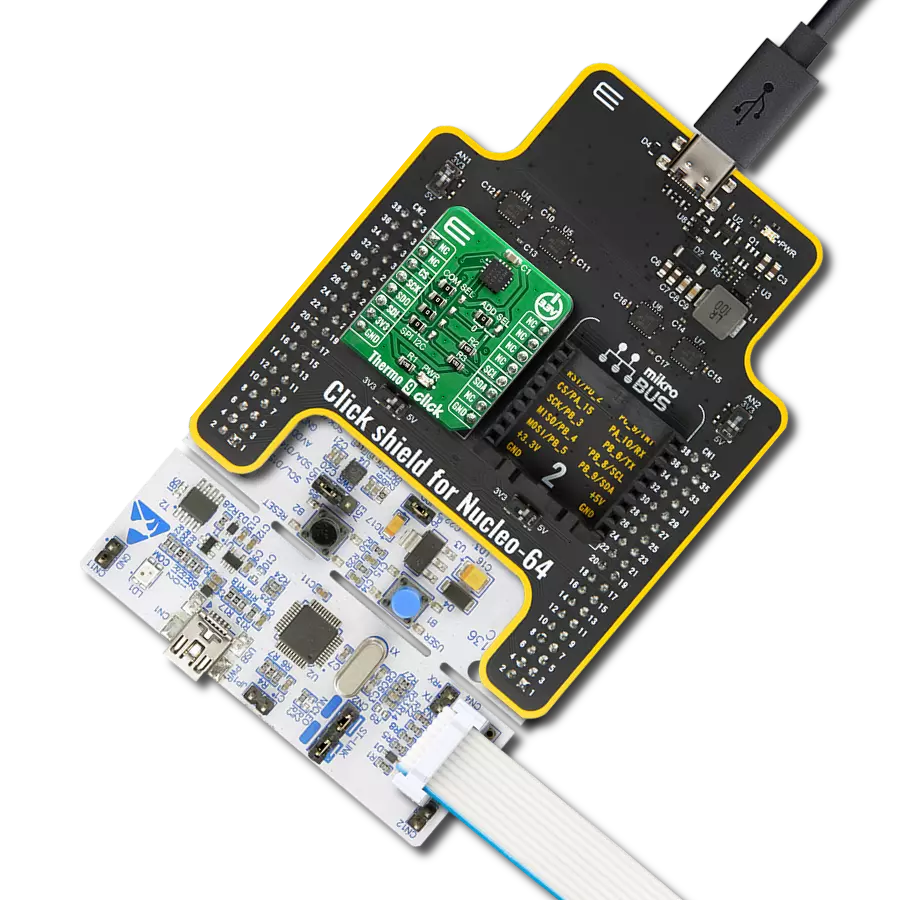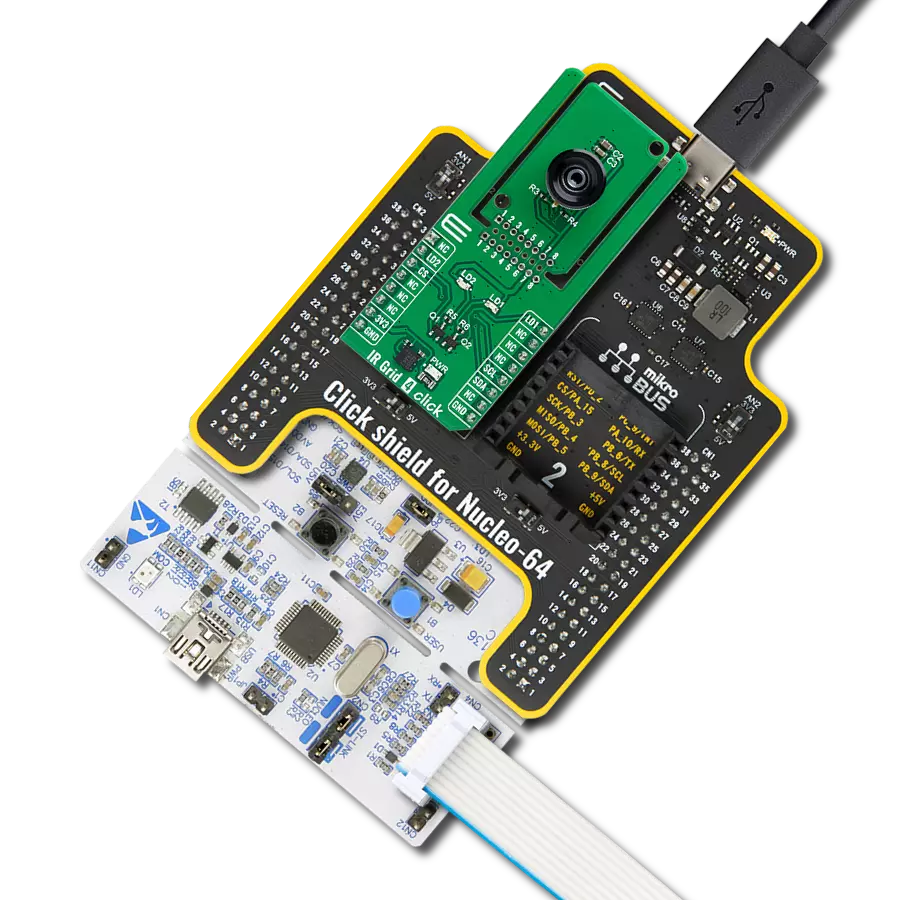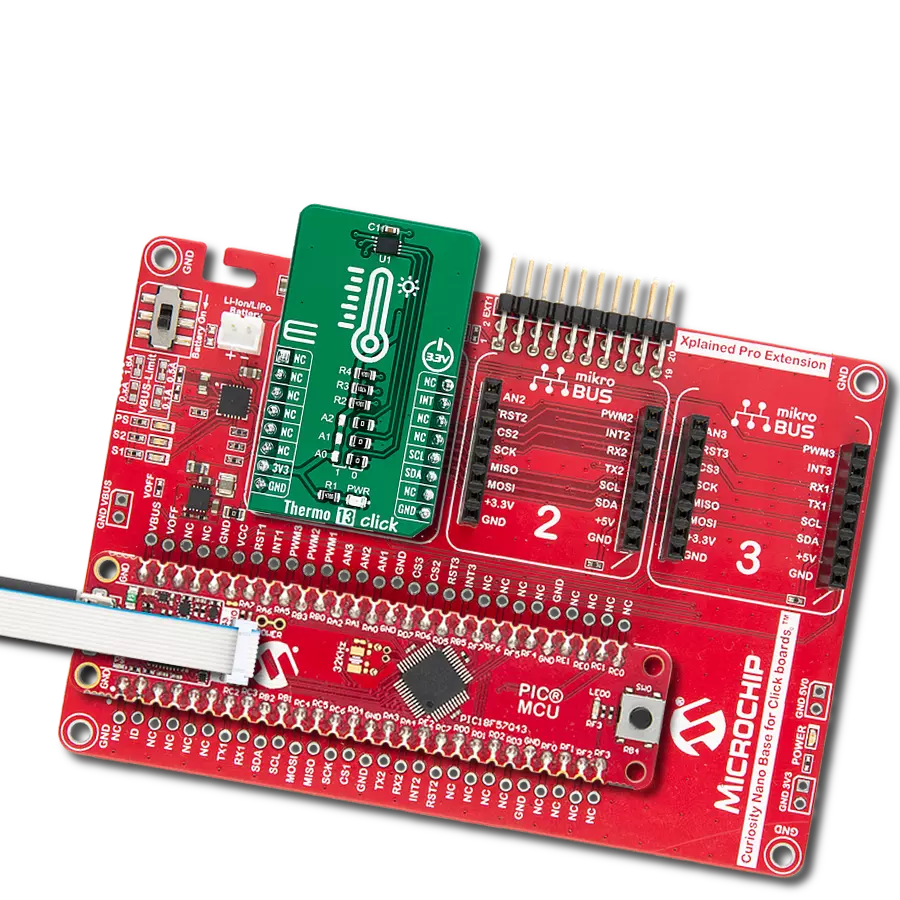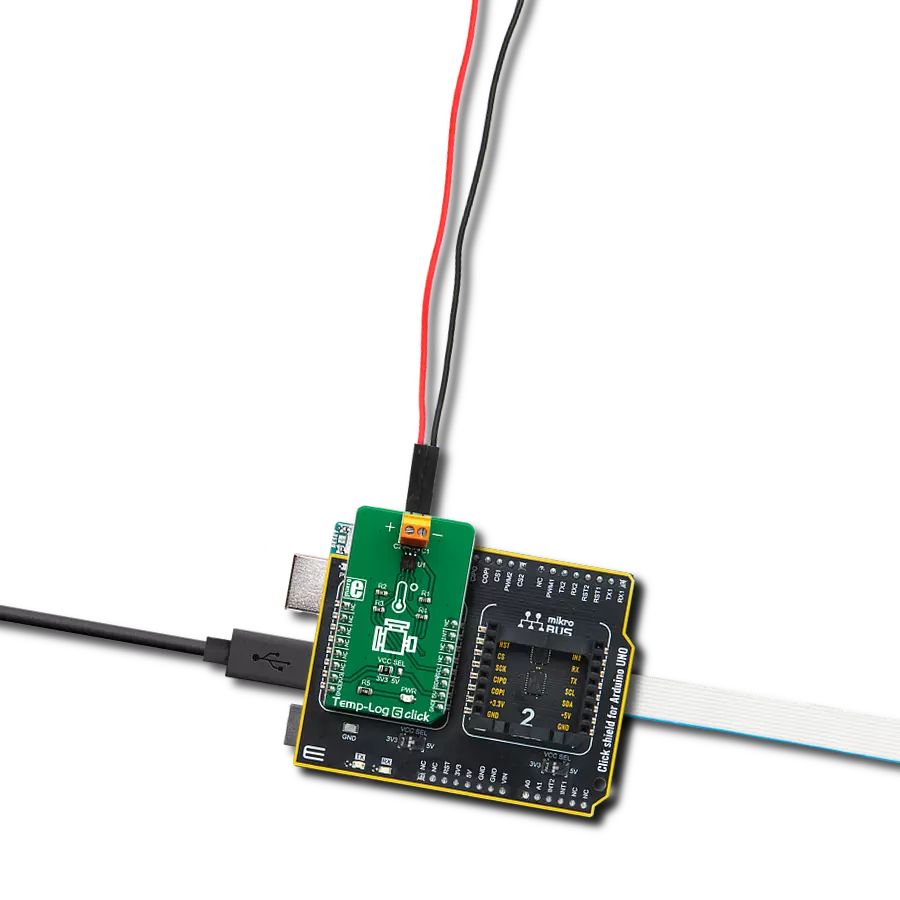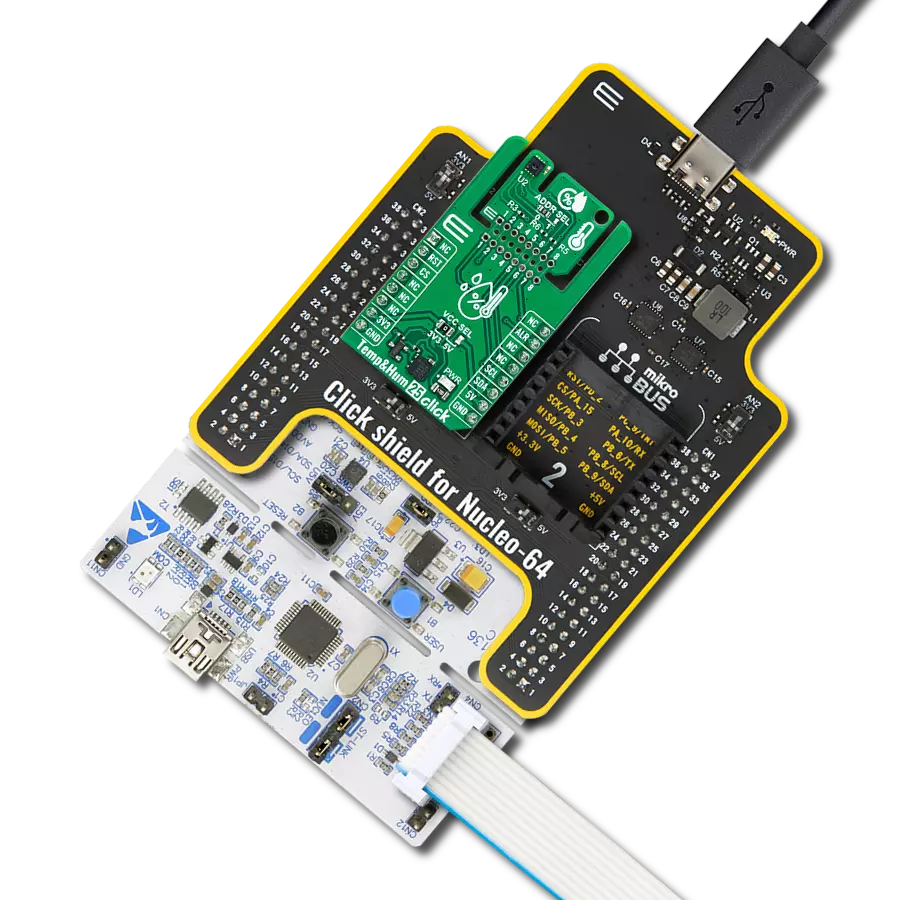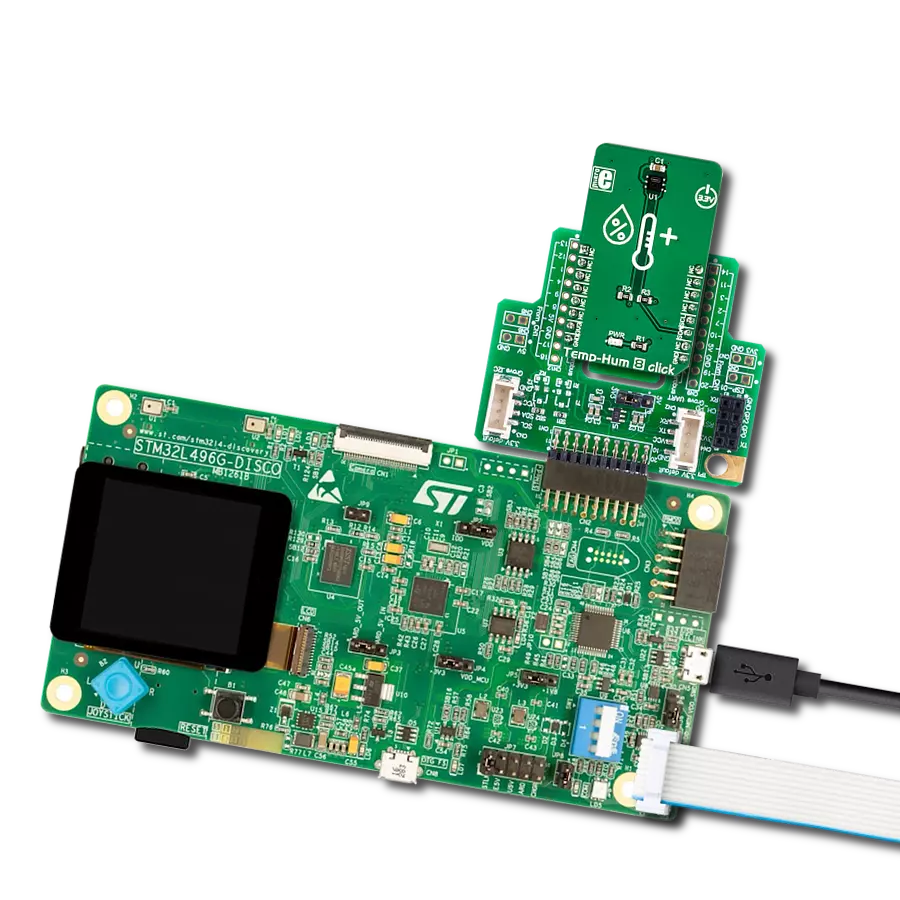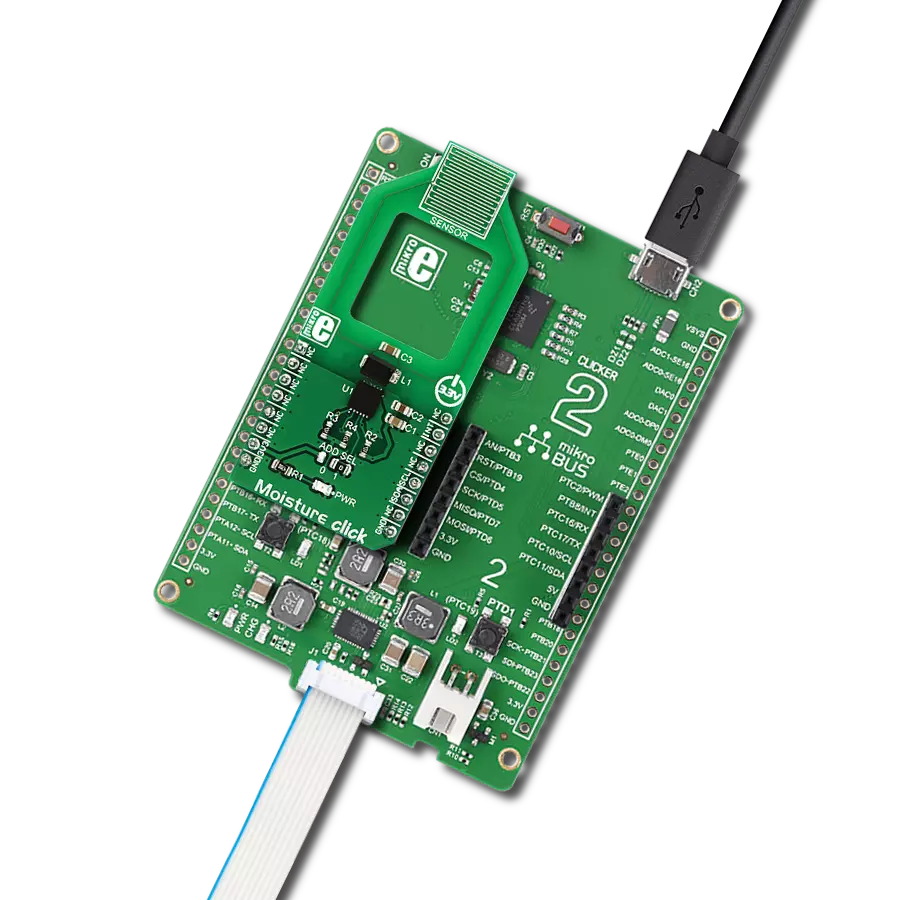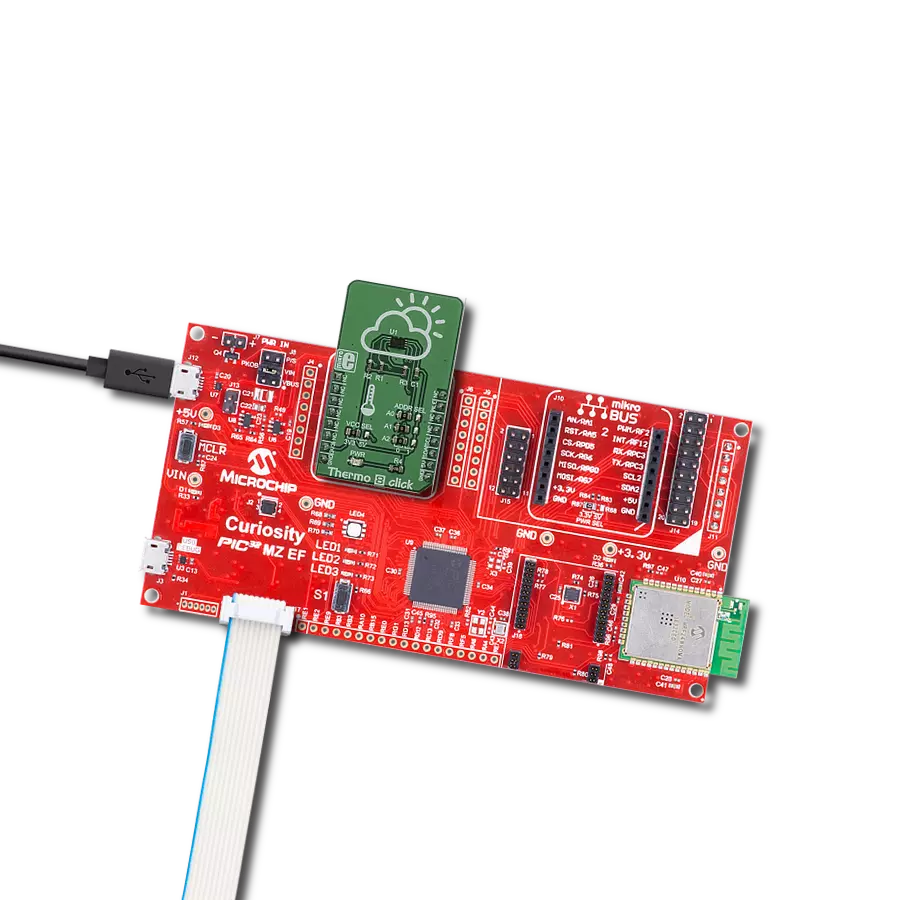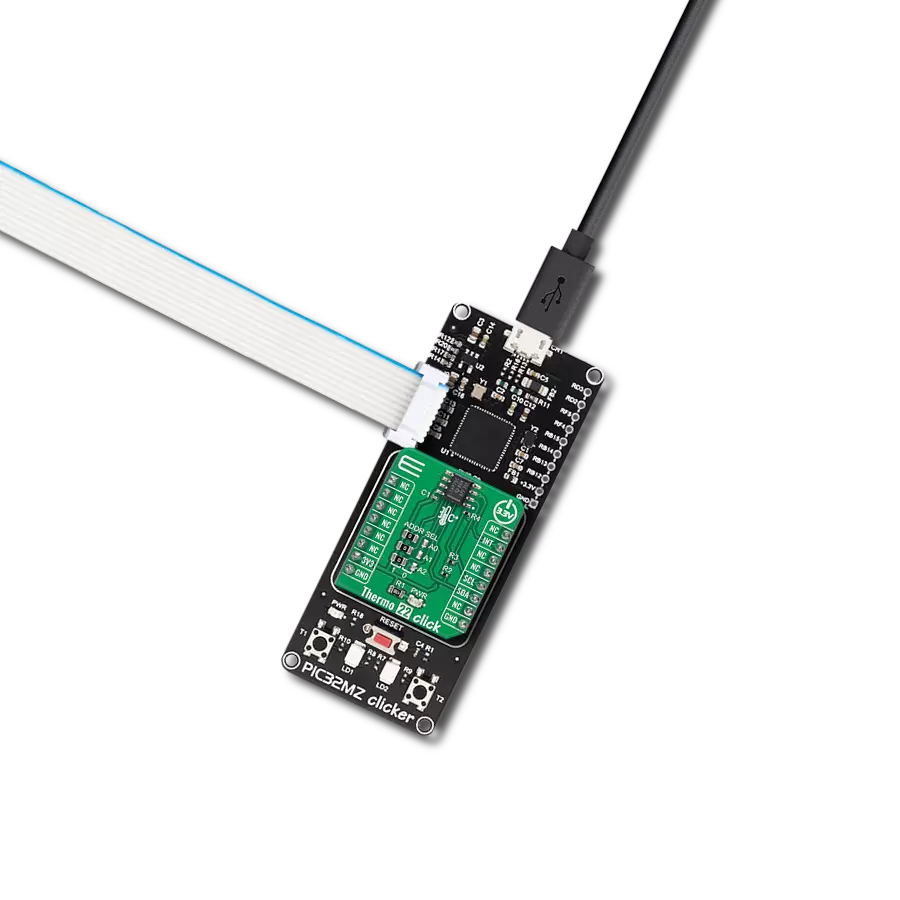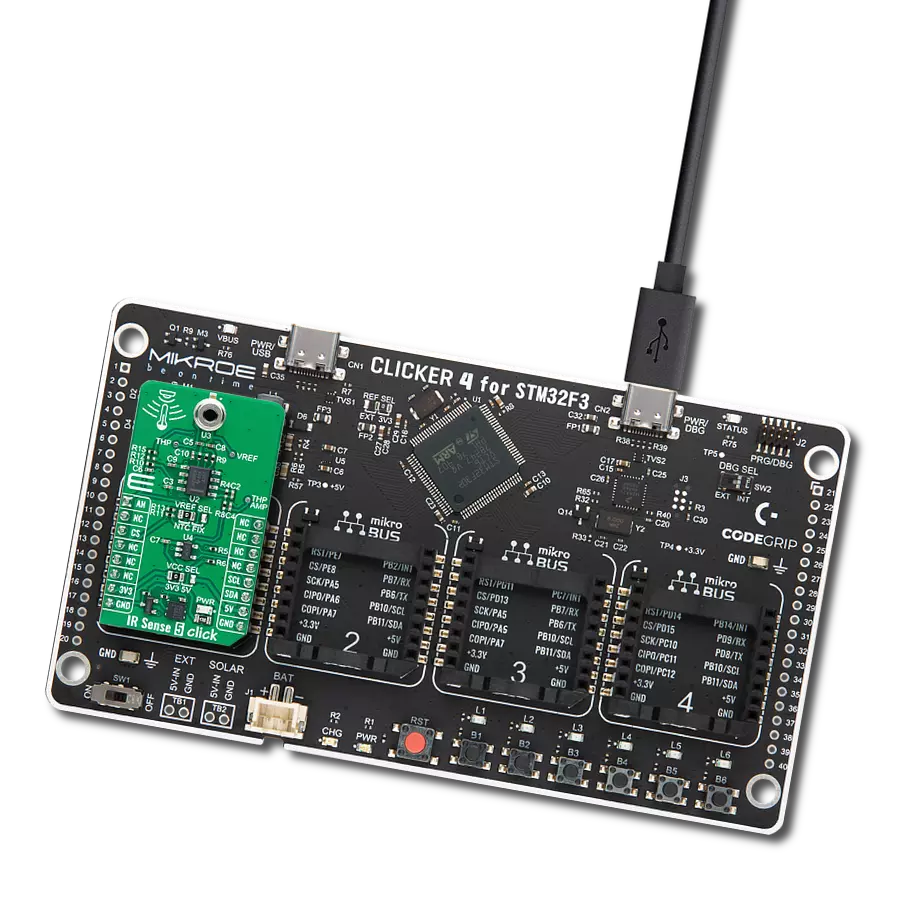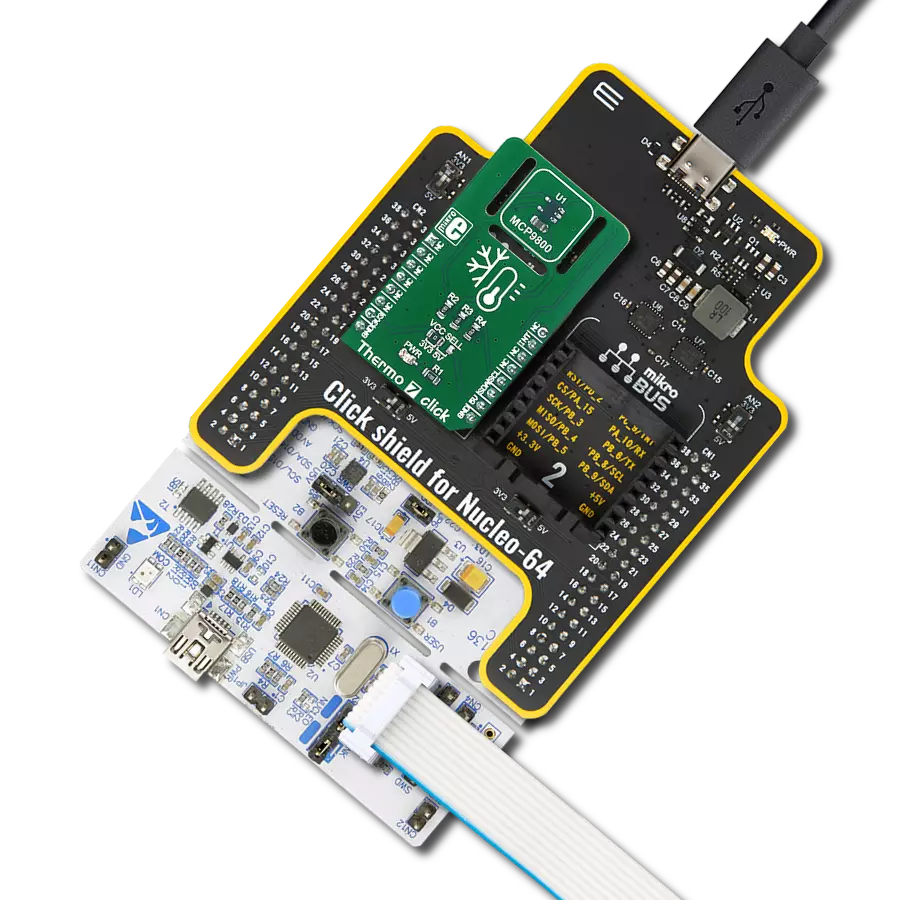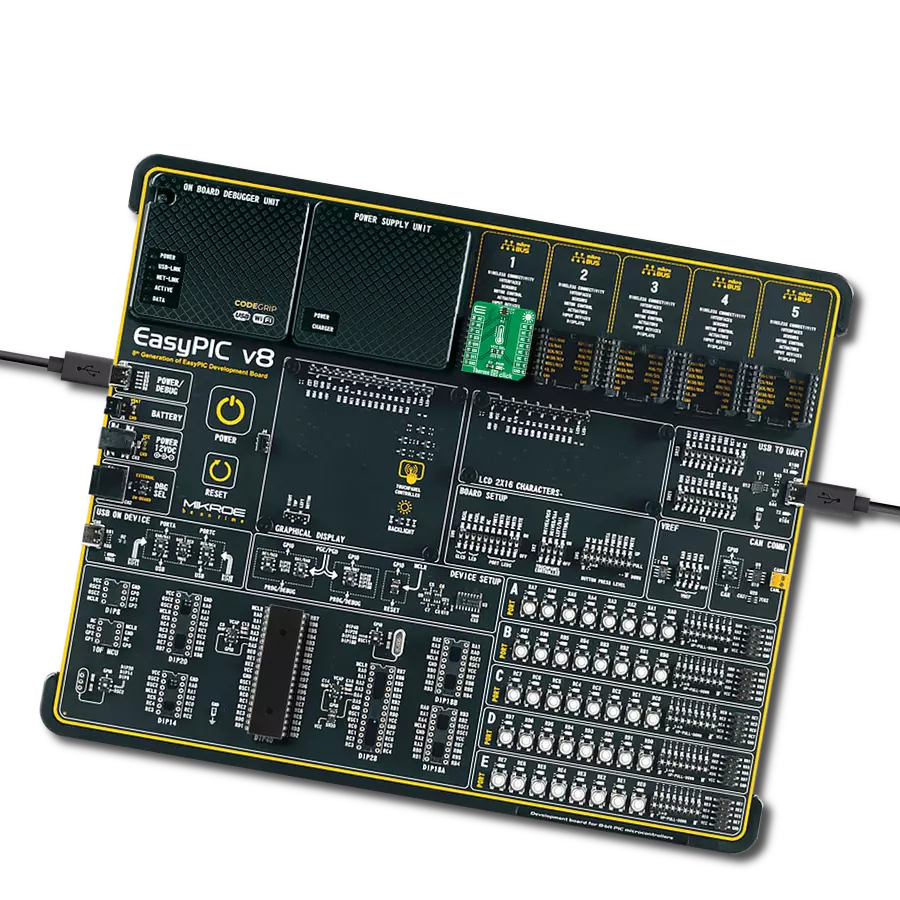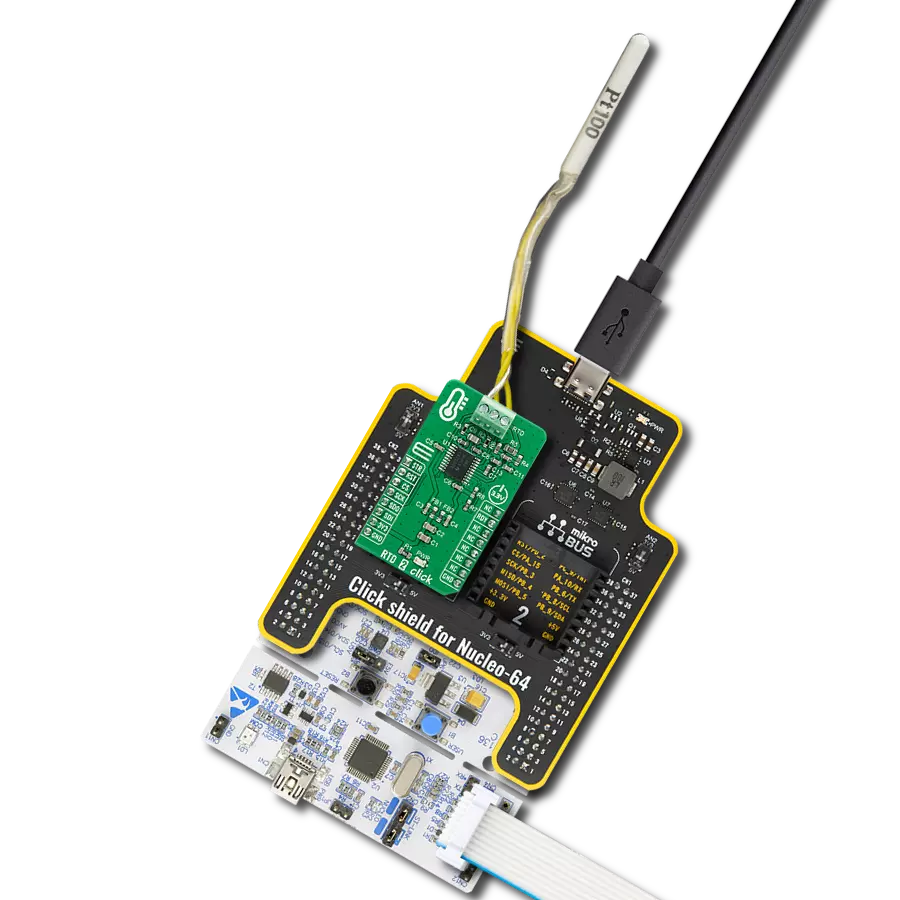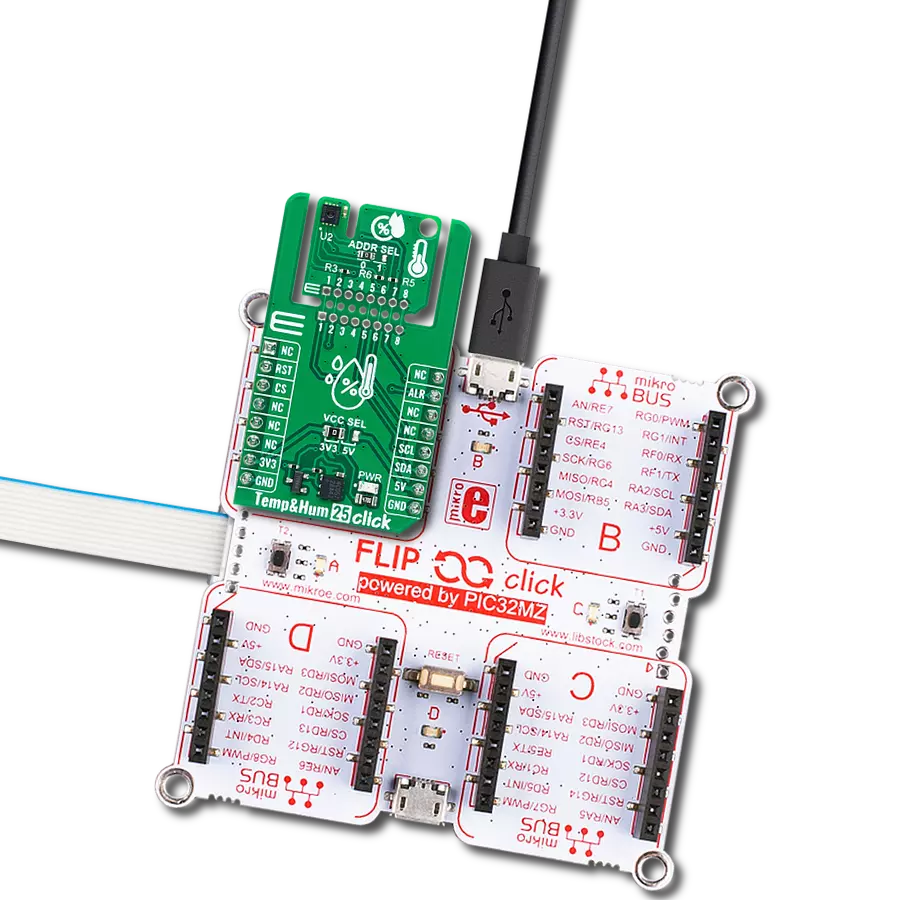Useful for environmental monitoring stations, weather data collection, or agriculture applications where temperature and humidity are crucial factors
A
A
Hardware Overview
How does it work?
Temp&Hum 25 Click is based on the SHT33-DIS-B2.5KS, a high-reliability, third-generation relative humidity and temperature sensor from Sensirion. This advanced sensor is part of Sensirion's new family of low drift digital calibrated and ISO17025-certified sensors, offering exceptional accuracy and reliability. The SHT33-DIS-B2.5KS integrates ISO17025-certified temperature sensing with highly precise humidity measurements, all within a single small package. Using the industry-proven CMOSens® technology, this sensor provides enhanced computational power, increased reliability, and superior accuracy compared to its predecessors. Its robust performance and reliability make it a versatile choice for a wide range of temperature and humidity-related applications in portable electronics and industrial, consumer, and environmental scenarios. Each SHT33 sensor is uniquely identifiable by its serial number and comes with an ISO17025-certified calibration certificate for temperature measurements. The SHT33-DIS-B2.5KS operates within a range of 0-100% RH and -40 to +125°C, with optimal performance achieved within the recommended temperature and humidity range of 5°C-60°C and
20%RH-80%RH, respectively. While long-term exposure to conditions outside these normal ranges, particularly high humidity, may temporarily offset the relative humidity signal, the sensor will re-calibrate itself upon returning to normal conditions. However, prolonged exposure to extreme environments can accelerate sensor aging. Additional notable features include its full functionality in condensing environments and true NIST-traceability, ensuring reliable and accurate measurements in various conditions. This Click board™ is designed in a unique format supporting the newly introduced MIKROE feature called "Click Snap." Unlike the standardized version of Click boards, this feature allows the main sensor area to become movable by breaking the PCB, opening up many new possibilities for implementation. Thanks to the Snap feature, the SHT33-DIS-B2.5KS can operate autonomously by accessing its signals directly on the pins marked 1-8. Additionally, the Snap part includes a specified and fixed screw hole position, enabling users to secure the Snap board in their desired location. Temp&Hum 25 Click uses a standard 2-Wire I2C interface to communicate with the host MCU with fast-mode support and
frequencies up to 1MHz. In addition to I2C pins, the device allows the selection of I2C addresses between 0x44 and 0x45 via an SMD jumper marked as ADDR SEL (0 set by default). The SHT33-DIS-B2.5KS can be reset via the RST pin of the mikroBUS™ socket, through a general call, or software as a soft reset. Resetting over the RST pin or through a general call (according to I2C specifications) achieves a full reset, while with the soft reset, the sensor resets the system controller and reloads calibration data from memory. In addition, this Click board™ comes with an additional interrupt alert signal, routed on the ALR pin of the mikroBUS™ socket, to provide a notification of ambient temperature and relative humidity measurements that violate programmed thresholds. This Click board™ can operate with either 3.3V or 5V logic voltage levels selected via the VCC SEL jumper. This way, both 3.3V and 5V capable MCUs can use the communication lines properly. Also, this Click board™ comes equipped with a library containing easy-to-use functions and an example code that can be used as a reference for further development.
Features overview
Development board
Nucleo-64 with STM32F410RB MCU offers a cost-effective and adaptable platform for developers to explore new ideas and prototype their designs. This board harnesses the versatility of the STM32 microcontroller, enabling users to select the optimal balance of performance and power consumption for their projects. It accommodates the STM32 microcontroller in the LQFP64 package and includes essential components such as a user LED, which doubles as an ARDUINO® signal, alongside user and reset push-buttons, and a 32.768kHz crystal oscillator for precise timing operations. Designed with expansion and flexibility in mind, the Nucleo-64 board features an ARDUINO® Uno V3 expansion connector and ST morpho extension pin
headers, granting complete access to the STM32's I/Os for comprehensive project integration. Power supply options are adaptable, supporting ST-LINK USB VBUS or external power sources, ensuring adaptability in various development environments. The board also has an on-board ST-LINK debugger/programmer with USB re-enumeration capability, simplifying the programming and debugging process. Moreover, the board is designed to simplify advanced development with its external SMPS for efficient Vcore logic supply, support for USB Device full speed or USB SNK/UFP full speed, and built-in cryptographic features, enhancing both the power efficiency and security of projects. Additional connectivity is
provided through dedicated connectors for external SMPS experimentation, a USB connector for the ST-LINK, and a MIPI® debug connector, expanding the possibilities for hardware interfacing and experimentation. Developers will find extensive support through comprehensive free software libraries and examples, courtesy of the STM32Cube MCU Package. This, combined with compatibility with a wide array of Integrated Development Environments (IDEs), including IAR Embedded Workbench®, MDK-ARM, and STM32CubeIDE, ensures a smooth and efficient development experience, allowing users to fully leverage the capabilities of the Nucleo-64 board in their projects.
Microcontroller Overview
MCU Card / MCU
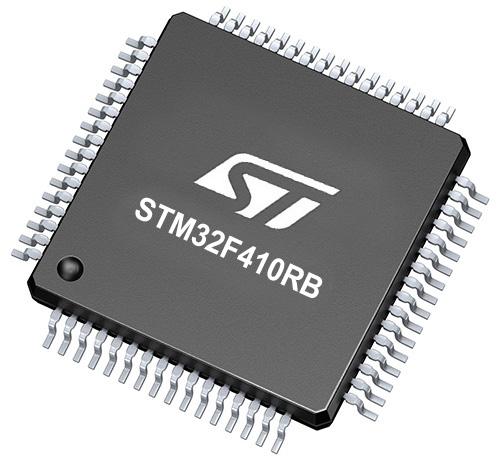
Architecture
ARM Cortex-M4
MCU Memory (KB)
128
Silicon Vendor
STMicroelectronics
Pin count
64
RAM (Bytes)
32768
You complete me!
Accessories
Click Shield for Nucleo-64 comes equipped with two proprietary mikroBUS™ sockets, allowing all the Click board™ devices to be interfaced with the STM32 Nucleo-64 board with no effort. This way, Mikroe allows its users to add any functionality from our ever-growing range of Click boards™, such as WiFi, GSM, GPS, Bluetooth, ZigBee, environmental sensors, LEDs, speech recognition, motor control, movement sensors, and many more. More than 1537 Click boards™, which can be stacked and integrated, are at your disposal. The STM32 Nucleo-64 boards are based on the microcontrollers in 64-pin packages, a 32-bit MCU with an ARM Cortex M4 processor operating at 84MHz, 512Kb Flash, and 96KB SRAM, divided into two regions where the top section represents the ST-Link/V2 debugger and programmer while the bottom section of the board is an actual development board. These boards are controlled and powered conveniently through a USB connection to program and efficiently debug the Nucleo-64 board out of the box, with an additional USB cable connected to the USB mini port on the board. Most of the STM32 microcontroller pins are brought to the IO pins on the left and right edge of the board, which are then connected to two existing mikroBUS™ sockets. This Click Shield also has several switches that perform functions such as selecting the logic levels of analog signals on mikroBUS™ sockets and selecting logic voltage levels of the mikroBUS™ sockets themselves. Besides, the user is offered the possibility of using any Click board™ with the help of existing bidirectional level-shifting voltage translators, regardless of whether the Click board™ operates at a 3.3V or 5V logic voltage level. Once you connect the STM32 Nucleo-64 board with our Click Shield for Nucleo-64, you can access hundreds of Click boards™, working with 3.3V or 5V logic voltage levels.
Used MCU Pins
mikroBUS™ mapper
Take a closer look
Click board™ Schematic

Step by step
Project assembly
Software Support
Library Description
This library contains API for Temp&Hum 25 Click driver.
Key functions:
temphum25_read_serial_num- This function reads the 4-bytes unique serial number by using I2C serial interfacetemphum25_start_measurement- This function starts the measurement by sending the selected measurement commandtemphum25_read_measurement- This function reads the temperature and humidity measurements results
Open Source
Code example
The complete application code and a ready-to-use project are available through the NECTO Studio Package Manager for direct installation in the NECTO Studio. The application code can also be found on the MIKROE GitHub account.
/*!
* @file main.c
* @brief TempHum 25 Click example
*
* # Description
* This example demonstrates the use of TempHum 25 Click board by reading
* the temperature and humidity data.
*
* The demo application is composed of two sections :
*
* ## Application Init
* Initializes the driver, performs the device reset, reads and displays
* the sensor unique serial number, and then starts the measurements with 1 MPS.
*
* ## Application Task
* Reads the temperature (degC) and the relative humidity (%RH) data and
* displays the results on the USB UART approximately once per second.
*
* @author Stefan Filipovic
*
*/
#include "board.h"
#include "log.h"
#include "temphum25.h"
static temphum25_t temphum25;
static log_t logger;
void application_init ( void )
{
log_cfg_t log_cfg; /**< Logger config object. */
temphum25_cfg_t temphum25_cfg; /**< Click config object. */
/**
* Logger initialization.
* Default baud rate: 115200
* Default log level: LOG_LEVEL_DEBUG
* @note If USB_UART_RX and USB_UART_TX
* are defined as HAL_PIN_NC, you will
* need to define them manually for log to work.
* See @b LOG_MAP_USB_UART macro definition for detailed explanation.
*/
LOG_MAP_USB_UART( log_cfg );
log_init( &logger, &log_cfg );
log_info( &logger, " Application Init " );
// Click initialization.
temphum25_cfg_setup( &temphum25_cfg );
TEMPHUM25_MAP_MIKROBUS( temphum25_cfg, MIKROBUS_1 );
if ( I2C_MASTER_ERROR == temphum25_init( &temphum25, &temphum25_cfg ) )
{
log_error( &logger, " Communication init." );
for ( ; ; );
}
temphum25_reset_device ( &temphum25 );
uint32_t serial_num = 0;
if ( TEMPHUM25_OK == temphum25_read_serial_num ( &temphum25, &serial_num ) )
{
log_printf ( &logger, " Serial number: 0x%.8LX\r\n", serial_num );
}
temphum25_start_measurement ( &temphum25, TEMPHUM25_CMD_MEAS_CONT_REP_HIGH_MPS_1 );
log_info( &logger, " Application Task " );
}
void application_task ( void )
{
float temperature = 0;
float humidity = 0;
if ( TEMPHUM25_OK == temphum25_read_measurement ( &temphum25, &temperature, &humidity ) )
{
log_printf ( &logger, " Temperature: %.2f degC\r\n", temperature );
log_printf ( &logger, " Humidity: %.2f %%RH\r\n\n", humidity );
Delay_ms ( 1000 );
}
}
int main ( void )
{
/* Do not remove this line or clock might not be set correctly. */
#ifdef PREINIT_SUPPORTED
preinit();
#endif
application_init( );
for ( ; ; )
{
application_task( );
}
return 0;
}
// ------------------------------------------------------------------------ END
Additional Support
Resources
Category:Temperature & humidity




















